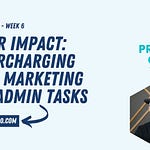Welcome back to our AI for Impact series! Last week, we explored the fundamental question: "What is AI and why does it matter for nonprofits?" You learned the basics of AI and even started experimenting with tools like ChatGPT, Gemini, and CoPilot.
QUICK NOTE: If you haven’t already, join our community for Project 900 here. And, thanks to my friends at Green Mellen for supporting the community.
This week, we're taking it a step further. Our mission today is to get you even more comfortable with these powerful tools, introduce a couple of new ones, and show you how to truly integrate them into your daily workflow to boost your nonprofit's productivity. Get ready to turn AI into your personal assistant!
Expanding Your AI Toolkit: Quick Introductions
You've already met some of the key players from Week 1. Let's quickly review them and then introduce two new, incredibly valuable tools.
Reviewing Familiar Faces:
ChatGPT & Gemini: Think of these as your go-to, versatile conversational partners. They're excellent for general tasks like brainstorming ideas, drafting various types of text, answering questions, and even helping with creative writing. If you need a quick draft or a fresh perspective, these are often your first stop.
CoPilot (Microsoft): If your nonprofit uses Microsoft 365 (Word, Excel, PowerPoint, Outlook, Teams), CoPilot is your built-in AI assistant. It integrates directly into these applications, helping you draft emails in Outlook, summarize meetings in Teams, or create documents in Word. It's designed for seamless productivity within the Microsoft ecosystem.
Meeting New Allies:
Claude (from Anthropic): Claude is an AI assistant that truly shines when dealing with longer texts and complex reasoning. Imagine needing to quickly understand a lengthy grant application guideline, summarize a detailed research report, or analyze a dense policy document. Claude's ability to process and understand large amounts of information makes it incredibly useful for these tasks, helping you digest information faster.
NotebookLM (from Google): This tool is quite unique because it's a "grounded" AI. This means it learns only from the documents you provide. You can upload your own PDFs, website links, Google Docs, or other files, and NotebookLM becomes an expert on your specific content. This is incredibly powerful for ensuring factual accuracy from your trusted sources and for tasks like internal research, summarizing your own reports, or extracting information from your organization's website.
The Art of "Talking to AI": Getting the Best Results
Using AI effectively isn't about being a tech expert; it's about learning how to communicate clearly with it. Think of AI as an incredibly smart, but very literal, assistant. It can only work with the instructions you give it.
The Golden Rule: Be Clear, Specific, and Provide Context.
Avoid vague requests like "Write something." Instead, be as precise as possible, giving the AI all the information it needs to understand your request.
Key Elements of Effective Prompts (Your "AI Instructions"):
Role/Persona: Tell the AI who to "be" or what perspective to take. This helps it adopt the right tone and style for your output.
Example: Instead of just "Write an email," try "Act as a seasoned grant writer for a youth development nonprofit."
Task/Goal: Clearly state what you want the AI to do.
Example: "Draft a thank-you email," "Summarize this article," "Brainstorm 5 ideas for..."
Context & Details: Provide all the necessary background information. Who is the audience? What's the purpose? What's the desired length or format? The more details, the better the result.
Example: "for our long-term donor base," "keep it under 150 words," "in bullet points," "the purpose is to thank them for their annual gift to our food pantry program."
Iteration: AI is a conversational tool. Don't expect perfection on the first try! If the first response isn't quite right, refine your prompt. It's like a dialogue.
Example: After a first response, you might say, "Make it more empathetic," "Add a stronger call to action at the end," or "Can you rephrase that to be more formal?"
Important Reminder:
Always remember that AI is a tool to assist you. It's crucial to always review AI-generated output for accuracy, potential bias, and to ensure it perfectly matches your nonprofit's unique voice and mission. Your human judgment and oversight are irreplaceable.
AI as Your Daily Productivity Partner: Practical Applications
Now, let's explore how you can weave these AI tools into your everyday work to save time and enhance your output. For these examples, feel free to try them out with ChatGPT or Gemini, or any other tool you have access to.
Drafting Initial Communications:
Emails: Imagine needing to send a quick thank-you to a new volunteer, an invitation to an upcoming event, or an internal team update. AI can swiftly draft initial versions.
Try this prompt: "Draft a warm email thanking a new volunteer, Sarah, for her first shift at our community garden. Mention the impact of her work on providing fresh produce for local families. Include a line about future opportunities."
Social Media Posts: Need engaging content for your social channels? AI can help you craft quick updates, compelling campaign announcements, or calls to action.
Try this prompt: "Write a short, inspiring social media post (for Instagram) announcing our upcoming 'Walk for Water' charity event. Encourage sign-ups and mention the cause."
Website Snippets: For quick headlines, short descriptions, or calls to action on your website, AI can provide options faster than starting from scratch.
Meeting Preparation & Recap:
Preparation: Before a meeting, AI can help you brainstorm agenda points, anticipate potential questions, or even do quick background research on attendees or topics.
Try this prompt: "Generate 5 key discussion points for a quarterly board meeting focused on our organization's fundraising strategy for the next year."
Recap: If you have notes or even a transcript from a meeting, AI can summarize key decisions, action items, and next steps. Remember: AI summaries are a starting point; always human-review for accuracy and completeness.
Try this prompt: "From these meeting notes [paste your notes here], extract the main decisions made and list any action items with who is responsible."
Ideation & Brainstorming:
Fundraising Campaigns: Stuck on your next big fundraising idea? AI can help you brainstorm new approaches, themes, or target audiences.
Try this prompt: "Brainstorm 3 unique, low-cost fundraising event ideas for a youth mentorship program that appeal to young adults."
Program Development: Explore innovative solutions to community needs by asking AI to generate concepts based on specific challenges or demographics.
Content Creation: AI is fantastic for sparking ideas for blog posts, newsletter topics, or educational materials.
Strategic Planning Support:
Outlines: AI can help you get started with initial drafts for vision statements, mission refinement, goal setting, or even outlines for SWOT analyses.
Research Summaries: If you have piles of external reports, market trends, or demographic data, AI can quickly condense it into digestible summaries relevant to your strategic planning.
Share Your Experience!
Share your insights and what you discovered in the comments below! We'd love to hear about your experience and how you envision using this feature.











Share this post